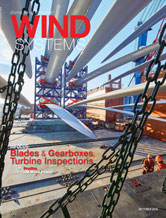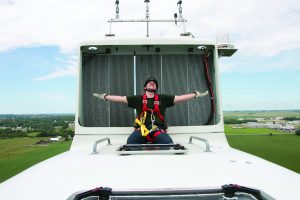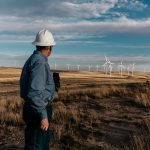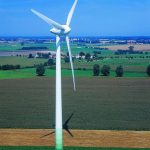Before the next maintenance inspection for a wind turbine, much can happen. At every turn, critical components can be moving toward failure. Wind turbines are complex systems integrating thousands of components and will be buffeted by many of the same operational and maintenance issues associated with any machinery. And fixes to the systems can be costly in time, money, and wind-farm productivity.
When unplanned turbine downtime becomes unavoidable because an essential component has failed without warning, potentially sky-high costs can follow. Expensive cranes may have to be transported and mobilized on land or offshore to access the trouble spots; replacement parts will need to be sourced and delivered, and technicians may have to be redeployed from other essential tasks to handle the immediate problem.
With the reliability and productivity of wind turbines hanging in the balance, technologies to monitor and track deteriorating component conditions in real time have gained considerable interest and applications. When the market was still in its relative infancy, condition-monitoring systems specifically engineered for turbines were few and far between. Today, as the industry has begun to mature in various regions, most new turbines will be equipped with some level of monitoring system to keep turbine health current.
But for unmonitored installations, performance can go awry with little or no advance notice. With the typical 20-year service life for the average wind turbine, it is not a question of “if” but “when” maintenance attention will be required. Proactive monitoring of critical wind-turbine components can eliminate many of the unknowns, while unlocking optimized capacity and long-term profitability on the wind farm.

Turning to components
Most large, modern wind turbines are horizontal-axis types. Their primary components include blades or rotors (which convert the energy in the wind to rotational-shaft energy), drive train (usually including a gearbox and generator), tower (support structure for the rotor and drive train), and other equipment, including controls, electrical cables, ground support, and interconnection equipment.
When a wind turbine fails, on-site technicians likely will be the first responders. However, the resolution to remedy the failure will vary by installation. Operators may rely upon OEMs, independent repair and maintenance contractors, their own in-house technicians, or a combination. Local distributors will be enlisted to supply components for out-of-warranty repair.
Advance warning can make a substantial difference in keeping turbines productive and operating reliably, while promoting timely maintenance practices in the process. Successfully transferred from applications in other industries, condition-monitoring systems (CMS) enable early detection and diagnosis of potential component failures and serve as a platform for implementing condition-based maintenance (CBM) practices. CMS also can detect wind-turbine problems from causes other than component failure, such as rotor imbalance due to icing and electrical faults.
Detecting problems
Condition monitoring is a strategy whereby physical parameters (including vibration, temperature, lubrication particles, and others) are measured regularly to determine equipment condition. This process makes it possible to detect machine and component problems before they can lead to unexpected downtime and unplanned costs from maintenance and lost production.
An online condition-monitoring system offers a powerful tool for managing day-to-day maintenance routines inside a wind turbine and consolidating risky, costly maintenance activities. By equipping operators to monitor and track deteriorating component conditions around-the-clock in real-time, expedient maintenance decisions can be based on actual machine conditions instead of arbitrary maintenance schedules. Mounted sensors and related software do the work and pinpoint the problems. Along the way, costs can be saved and unscheduled downtime can be minimized.
The principles of condition monitoring are not new, but the proactive approach has gained significant ground in the industry due to the increasingly sophisticated computational interpretation and analysis capabilities for measured data. CMS data can be applied to adjust scheduled maintenance intervals and strike an ideal balance between the cost of maintenance and the cost of unscheduled fault repairs.
In addition, monitoring systems can enhance and optimize maintenance forecasting by continuously recalculating fault frequencies and delivering accurate values based on reliable trends. This can facilitate the assigning of alarms at various speeds and loads, including low main shaft speeds, and form the basis for trend-based root-cause failure analysis.
Most monitoring systems can accommodate a large population of turbines and multiple data points. Using vibration sensors mounted on a turbine’s main shaft bearings, gearbox, and generator, systems (in tandem with software) will continuously monitor and track a wide range of operating conditions for analysis.
Wireless capabilities expand system potential by offering a way to review data remotely from any location with a computer or hand-held device with internet access. This can shorten lead-time from alarm to solution.
Evaluating conditions
Operating conditions that can be targeted for early detection, diagnosis, and remedial action include:
- Unbalanced turbine blades
- Misalignment
- Shaft deflections
- Mechanical looseness
- Foundation weakness
- Bearing condition
- Gear damage
- Generator rotor/stator problems
- Resonance problems
- Tower vibrations
- Blade vibrations
- Electrical problems
- Improper or inadequate lubrication
An example of one of the more comprehensive condition-monitoring systems in use at many installations around the world illustrates the advantages.
This particular system is grounded in an “intelligent” monitoring unit, which is mounted inside the turbine’s nacelle. The unit features 16 different channels where multiple measurement points can be connected. A typical wind-turbine configuration would incorporate the main bearing (one channel), gearbox (four channels), generator (two channels), and tachometer (one channel). In addition, other monitoring points can be added, including tower/structure vibration, blade vibration, oil temperature, oil pressure, oil quality, and generator temperature.
This system applies built-in hardware auto-diagnostics, which continuously check all sensors, cabling, and electronics for any faults, signal interruption, shorts, or power failures. Any malfunction triggers an alarm.
Such a system even allows operators to use the information to control or postpone repairs, as one SKF customer discovered.
In this customer’s case, a monitoring unit was eventually installed on a wind turbine that had been experiencing consistent damage to the low-speed part of its gearbox. After installation, the monitoring system performed as intended and beyond. The system not only registered the damage, but also determined the damage was stable enough to postpone the gearbox replacement and keep the damaged turbine in operation.
After monitoring the damaged part for almost 12 months, the system eventually detected a rapid increase in the damage pattern, and only then was the turbine taken offline for gearbox replacement. By postponing the gearbox replacement for a year, the wind farm was able to generate interest on the capital needed for the overhaul and efficiently plan for parts delivery, shipping, personnel, and cranes for the job.
The alternative would have been a rushed operation accompanied by unnecessary costs, several weeks of downtime, and lost productivity.

Evolving technology
By tracking component health and evaluating data from monitoring, maintenance activities can be coordinated across the wind farm, service calls can be better planned and bundled, and operators can take advantage of planned shutdowns to service several turbines at the same time, since machinery conditions will be known from the monitoring.
A viable condition monitoring system ultimately can assist wind-farm operators in performing appropriate inspections, maintenance activities, and fixes at the right time when and where needed, regardless of the calendar. As a result, wind-farm operators can extend maintenance intervals, consolidate maintenance initiatives, cut operating costs and costs per kWh, reduce the risk of unplanned shutdowns, prevent lost energy production due to breakdowns, and predict remaining service life by turbine. All contribute economies and efficiencies for a wind-farm operation.
The monitoring process for a wind turbine can effectively reduce lifecycle costs and extend service life. Implementing necessary repairs when problems begin to surface, for example, proves easier and much less expensive than running a turbine to catastrophic failure.
Looking ahead, significant research and development is under way involving condition monitoring techniques, fault analysis, and optimized maintenance procedures. The evolving technology intends to help keep operating and maintenance costs to modest levels and contribute overall toward the cost-effectiveness of wind-turbine technology.
The evolution is further continuing with a focus on ergonomics and improved diagnostics and prognostics. And technician requirements may change for the better with advances in technology, leading to improvements in the scheduling and deployment of manpower.
Above all, support is readily available. One of the best practices in navigating the challenges of wind-farm operations and maintenance is to partner with an established services provider experienced in the many interrelated aspects of wind-turbine technology. This will inform operators with the most current engineering resources to help keep the blades turning productively.
For more information, go to www.skfusa.com

































